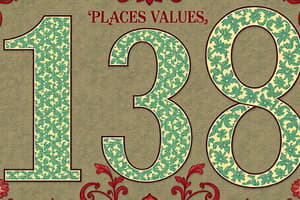Podcast
Questions and Answers
In the number 7369, what is the place value of the digit 6?
In the number 7369, what is the place value of the digit 6?
- 60
- 6
- 600 (correct)
- 6000
What is the correct order of the following numbers: 410, 304, 241, 413?
What is the correct order of the following numbers: 410, 304, 241, 413?
- 413, 304, 241, 410
- 413, 410, 304, 241
- 410, 304, 241, 413
- 410, 413, 304, 241 (correct)
Which of the following is true when comparing 398 and 493?
Which of the following is true when comparing 398 and 493?
- 398 is less than 493 (correct)
- 398 is greater than 493
- The first digit in 398 is less than the first digit in 493
- The place values do not affect the comparison
Why is the number 7495 greater than 7415?
Why is the number 7495 greater than 7415?
If a digit is in the thousands place, what is its place value?
If a digit is in the thousands place, what is its place value?
What does place value refer to?
What does place value refer to?
In the number 741, what does the digit 4 represent?
In the number 741, what does the digit 4 represent?
Which is larger: 528 or 582?
Which is larger: 528 or 582?
If a number has a digit 0 in the thousands place, what does this indicate?
If a number has a digit 0 in the thousands place, what does this indicate?
What does the digit in the units place represent in a number?
What does the digit in the units place represent in a number?
When comparing numbers, why is the 7 in 732 greater than the 2 in 247?
When comparing numbers, why is the 7 in 732 greater than the 2 in 247?
Flashcards are hidden until you start studying
Study Notes
Place Value
Place value refers to the concept that values of places holders vary according to their placement, such as hundreds, tens, and units. This system is essential for understanding large numbers and performing calculations effectively.
Reading and Writing Numbers
To read a number in base ten place value system, you need to understand the value of each digit based on its position or place. For example, consider the number 2035:
- The rightmost digit 5 represents ones (units), which is worth one unit.
- The next column on the left has a 3, standing for tens; this is worth 3 tens.
- Moving further to the left is another column with a 2; it represents hundreds, so this part is worth 2 hundred.
- Finally, there's a 0 at the farthest left column, representing thousands. However, since there are no digits following, we can assume that this part is equal to zero.
Similarly, to write a number, you assign appropriate digits based on their value to each column. For example, if you want to write a number equivalent to 1 thousand + 3 hundreds + 2 tens + 7 units, you would write the number as 1327.
Comparing Numbers
Comparing numbers involves understanding place value by looking at the value of digits in different places. For instance, when comparing 346 with 450, we know that each digit represents a power of ten based on its position from right to left. In this case, the 4 in the 10s place is greater than the 3 in the same place in the other number. Hence, 450 > 346.
Ordering Numbers
Ordering numbers follows the same logic as comparing them. To order two numbers, you just need to ensure that they are arranged correctly according to their place values. For example:
- 20 is smaller than 21 since the first digit in 21 is one more than in 20.
- 500 is greater than 250 since the first digit in 500 is five times more than the first digit in 250.
- 312 is smaller than 456 because 3 is less than 4 and the number of digits after the first one is less.
Identifying Place Value of Digits
To identify the place value of a digit, you need to know what each position or column represents. For example:
| Position | Place Value |
|---|---|
| Units | 1 |
| Tens | 10 |
| Hundreds | 100 |
| Thousands | 1000 |
| ... | ... |
In the number 4879, for instance, the 8 in units place has a place value of 8, while the 7 in tens place has a place value of 7 * 10 = 70, and so on for other places.
Studying That Suits You
Use AI to generate personalized quizzes and flashcards to suit your learning preferences.




